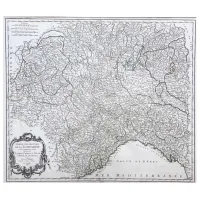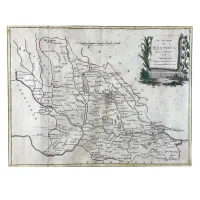Cellarius Andreas A pair of 18th century watercolor star maps
Luxury antiques
SKU: ANT-A1423
See other products from category Antique prints or from manufacturer Antyki with shipping within 24 hours
Description
The graphic originates from Harmonia Macrocosmica, a star atlas from the golden age of Dutch cartography, depicting the structure of the heavens on twenty-nine extraordinary double-page plates, published in Amsterdam in 1708 by Gerard Valk and Petrus Schenk. The magnificent celestial maps contained in this astronomical work illustrate the movement of the Sun, planets, and constellations, offering a historical overview of various cosmic theories advocated by Ptolemy, Copernicus, and Tycho Brahe, rather than new scientific discoveries. The beauty of the design and the richness of detail place them at the pinnacle of artistic cartography.
Each sheet measures 44 x 53 cm and is framed in a gilded wooden frame.
The first is a geocentric map of the sky based on the observations of the Greek poet Aratus, the second presents the model of the universe by the Danish astronomer Tycho Brahe.
As a compromise between the models of Ptolemy and Copernicus, the Danish astronomer Tycho Brahe proposed a model of the Universe with the Earth at the center and the Sun and Moon orbiting the Earth, while the remaining planets orbit the Sun. The four moons of Jupiter are depicted, and the zodiac signs are shown around the map. The map includes a portrait of Tycho Brahe in the lower right corner.
This pair of antique graphics with contemporary coloring comes from a private collection in Milan and, considering the date, is in good condition. On the underside of one of the two cuts, minimal scabs and two small holes are visible.
Original antique furniture and accessories can be an excellent idea for decorating our interiors. Today, there are more and more enthusiasts of high-quality old products that have a certain character and soul. It is a nod to the history, creation, and design of traditional and timeless furniture. There are many different styles in antique furniture, each with its distinctive features.
There are many different styles characterizing antique furniture, but we can distinguish a few key ones. Eclectic furniture belongs to the 19th century, which saw the reigning Biedermeier style. Its variations in the early years of this century include neo-Gothic, Gothic, Rococo, Louis Philippe style, and finally, the English Victorian style. By the end of the century, these styles transition into pseudo-styles of classicism, Renaissance, and Baroque.
Original Empire-style furniture dates from the period between the late 18th and early 19th centuries. It all stemmed from the reign of Napoleon. There, a significant resemblance and references to Roman and Greek decorations were imposed.
Classicist furniture is in the Louis XVI style, which also strongly references ancient architecture. Interesting and noteworthy are all antique products in the Rococo and Louis XV styles. Next is Baroque, whose name comes from the Portuguese barocco – which translates to an irregularly developed pearl. These were very representative pieces of furniture, meant to literally ooze glamour and play a significant role in luxury. Exceptional, selectively used materials were employed to further emphasize the lofty tone of these products.
Today, we can observe how much influence the Baroque style had on today's classic furniture, which is designed with great similarity to the past era. Another significant style is the Renaissance, which flourished in the 15th and 16th centuries and also left a large mark on the art of furniture making. The Renaissance style was quite heavy and massive. Brown stains were used, as well as cornices, strong plinths, and bas-reliefs. It can certainly be said that these were quite specific products, but they offered many new possibilities, such as the construction of sideboards or broadly understood chest furniture. Here, too, there was an interest in mythology and ancient times, so supports or legs took on animal forms.
Lion's paws, eagle heads – these are common sights in the Renaissance style. Currently, many global brands recreate such furniture, taking examples from Italian or French creators. It is a manifestation of admiration and care for the history of the most beautiful Renaissance antiques. It is important to remember that in each country, furniture making was perceived differently, so each style in a given country had its own distinct character. This is very important, especially when searching for the right luxury antique for your interior.
The most important aspect of stylish antique furniture is originality. This is ultimately crucial from the customer's perspective, as there are many counterfeits circulating in the market. The Luxury Products brand provides a document confirming the product's compliance with the actual description and photo. We have art appraisers, historians, and experts from around the world at your disposal.
Attributes / Details
| SKU | ANT-A1423 |
| Manufacturer | Antyki |
| Model | A1423 |
| Material | wood, watercolor |
| Size | Height: 59 cm Width: 67.5 cm Depth: 3 cm |
| Wiek | XVIII |
| Rok | 1700 |
| Destiny | To home |
See catalog
Reviews
No reviews for this product.
























